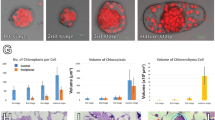Summary
-
1.
In fully senescent mesophyll cells from Phaseolus almost all the cytoplasmic contents had been lost apart from the resistant plasmalemma and some small empty vesicles. In some parts of the cell groups of plastids, together with occasional distorted mitochondria, spherosomes and a few ribosomes also remained. Such plastids were much smaller than those of normal cells and had a spherical shape. The surface membrane had remained intact and enclosed a group of spherical globules with dense structureless contents. All the thylakoids and the stromal ribosomes and starch, shown to be present in the stroma of normal cells, had been broken down. The globules are formed by the accumulation of lipids from thylakoid breakdown, and contain the lipid-soluble carotenoids freed at the same time.
-
2.
The earliest stage of senescence examined showed more or less intact cells apart from the accumulation of some globules within each chloroplast. Distortion of the thylakoids in the vicinity of these globules is considered to be evidence for their localized breakdown in the chloroplast.
-
3.
Because the well-ordered sequence in early senescence it is thought that wholesale release of hydrolytic enzymes would not account for this. At a later stage however, wholesale release of materials from various organelles would constitute a mopping-up process. Of particular significance here would be the vacuolar contents.
-
4.
It would seem from the findings of this investigation that the primary cause of the senescence sequence would be consistent with the appearance, either by synthesis or activation, of a specific enzyme complex which is capable of decomposing thylakoids in the chloroplast. It is thought that this enzyme would increase in quantity and move from the plastids to affect membranes around other organelles at a later stage.
Similar content being viewed by others
References
Avers, C. J.: Histochemical localization of enzyme activities in root meristem cells. Amer. J. Bot. 48, 137–142 (1961).
Butt, V. S.: Enzymic activity in plant cell walls and at protoplast surfaces. Abstr. Tenth Internat. Bot. Congr. Edinburgh 1964, p. 202.
Douglas, H. N., M. V. Laycock, and D. Boulter: The microelectrophoretic behaviour of plant mitochondria compared with rat mitochondria. J. exp. Bot. 14, 198–209 (1963).
Duve, C. de: Lysosomes, a new group of cytoplasmic organelles. Subcellular particles (ed. T. Hayashi), p. 128–159. 1959.
Frey-Wyssling, A., and E. Kreutzer: Die submikroskopische Entwicklung der Chromoplasten in den Blüten von Ranunculus repens L. Planta (Berl.) 51, 104–114 (1958a).
——, and E. Kreutzer: The submicroscopic development of chromatophores in Capsicum Capsicum annum. L. J. Ultrastruct. Res. 1, 397–411 (1958b).
Gahan, P. B.: Histochemical evidence for the presence of lysosome-like particles in rootmeristem cells of Vicia faba. J. exp. Bot. 16, 350–355 (1965).
Gunning, B. E. S.: Developmental processes in Avena chloroplasts. Twenty first meeting of the EM Society of America, Abstr. in J. appl. Phys. 34, 2529 (1963).
—, and W. K. Barkley: Kinin induced directed transport and senescence in detatched oat leaves. Nature (Lond.) 199, 262–265 (1963).
Holt, S. J., and R. M. Hicks: Combination of cytochemical staining methods for enzyme localization with electron microscopy.—In: The Interpretation of ultrastructure (ed. R. J. C. Harris), p. 193–213. 1962.
Ikeda, T., and R. R. Ueda: Light and electron microscopical studies on the senescence of chloroplasts in Elodea leaf cells. Bot. Mag. (Tokyo) 77, 336–341 (1964).
Lamport, D. T. A.: The protein component of primary walls.—In: Advances in botanical research, 2. ed. (R. D. Preston), p. 151–218. 1965.
—, and D. H. Northecote: Hydroxyproline in primary walls of higher plants. Nature (Lond.) 188, 665–666 (1960).
Marinos, N. G.: Studies on submicroscopic aspects of mineral deficiences I. Calcium deficiency in the shoot apex of Barley. Amer. J. Bot. 49, 834–841 (1962).
—: Studies on submicroscopic aspects of mineral deficiencies II. Nitrogen, pottasium, sulphur and magnesium deficiences in the shoot apex of Barley. Amer. J. Bot. 50, 998–1005 (1963).
Poux, N.: Localisation de la phosphatase acide dans les cellules méristématiques de blé (Triticium vulgare Vill.). J. de Microscopie 1, 485–490 (1962).
Seth, A. K.: The physiology of ripening and senescence. Ph. D. Thesis University College of Wales 1965.
Shaw, M., and M. S. Monocha: Fine structure in detatched senescing wheat leaves. Canad. J. Bot. 43. 747–755 (1965).
Thompson, W. W., and T. E. Weier: The fine structure of chloroplasts from mineral deficient leaves of Phaseolus vulgaris. Amer. J. Bot. 49, 1047–1055 (1962).
Author information
Authors and Affiliations
Rights and permissions
About this article
Cite this article
Barton, R. Fine structure of mesophyll cells in senescing leaves of Phaseolus . Planta 71, 314–325 (1966). https://doi.org/10.1007/BF00396319
Received:
Issue Date:
DOI: https://doi.org/10.1007/BF00396319



